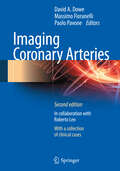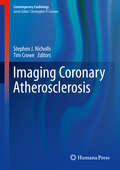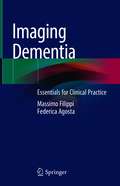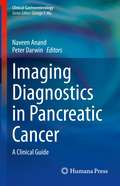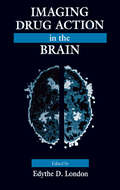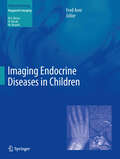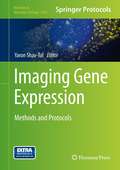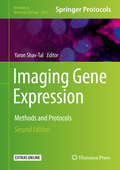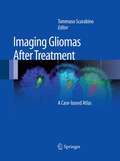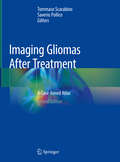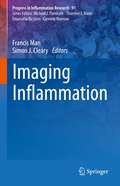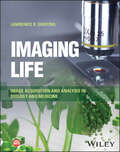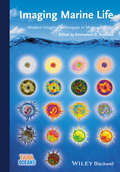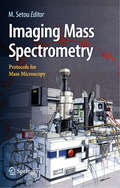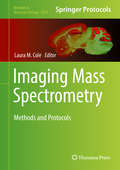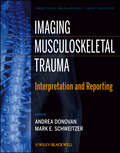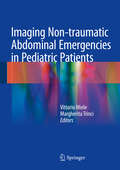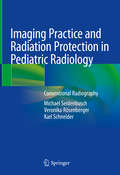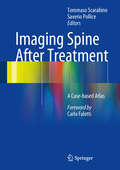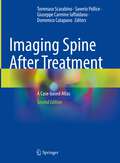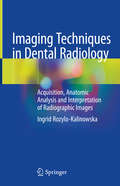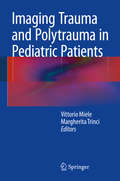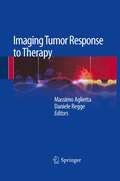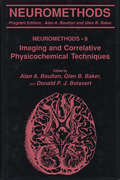- Table View
- List View
Imaging Coronary Arteries
by David A. Dowe Massimo Fioranelli Paolo PavoneIn non-fatal cases, cardiovascular diseases are associated with a decreased quality of life as well as a substantial economic burden to society. Most sudden cardiac events are related to the complications of a non-stenosing marginal plaque. For this reason, the ability to properly identify the atherosclerotic plaque with rapid, non-invasive techniques is of utmost clinical interest in diagnostic workup and therapeutic planning of symptomatic patient. Nowadays CT produces high-quality images of the coronary arteries, in addition to defining their location and the extent of the atherosclerotic involvement. This new edition is enriched with two important additions. Firstly, dedicated chapters on intravascular ultrasound (IVUS), catheter angiography, and nuclear imaging have been included, with some discussions on theoretical techniques such as optical coherence tomography (OCT) and magnetic resonance imaging (MRI). Secondly, a completely new section comprising more than 70 clinical cases remarkably expands the horizons reached by the previous edition. This volume provides general practitioners and cardiologists with a basic understanding of the imaging techniques. For radiologists with no direct experience in cardiac imaging, the book serves as an important source of information on coronary pathophysiology and anatomy.
Imaging Coronary Atherosclerosis
by Stephen J. Nicholls Tim CroweFor over 50 years, coronary angiography has been the mainstay of diagnosing and quantifying the extent of coronary artery disease However appreciation of the inherent limitations of conventional angiography has led to a plethora of new imaging modalities, each with their relative strengths and potential pitfalls. Advances in these techniques have given clinicians, as well as researchers, an overwhelming amount of information and the need for thoughtful interpretation. This outstanding book provides a comprehensive overview of the current status of imaging of coronary atherosclerosis Covering the wide variety of available imaging modalities, the book provides state-of-the-art knowledge from leading authorities in each area In their discussion, the authors include both invasive and non-invasive modalities, including the gold standard coronary angiography, the growing field of IVUS, and novel techniques such as functional imaging, molecular imaging, and the integration of biomarkers. The key concepts and practical information given in this volume will provide the reader with the necessary understanding to choosing appropriate imaging studies and building confidence in their skill set with each.
Imaging Dementia: Essentials for Clinical Practice
by Massimo Filippi Federica AgostaThis book helps physicians select from among the currently available imaging tools, promoting the correct and cost-saving diagnosis and management of common dementias. Magnetic resonance (MR) and nuclear medicine techniques are routinely used to facilitate diagnosis, select therapies, provide information regarding the prognosis, and monitor therapy response in patients with cognitive impairment and dementia. Furthermore, the advent of quantitative MR techniques, such as diffusion-weighted imaging, perfusion imaging, etc. have opened up new opportunities to diagnose neurological diseases based on objective findings, and offer unique new insights into the main neurodegenerative diseases of the human brain. However, the practical value of various neuroimaging techniques in clinical practice has yet to be clearly defined, and their potential for future development is not yet fully appreciated.To help remedy the situation, this book offers practical and useful algorithms and rules that can be directly applied in the clinical setting. It provides concise content, together with a wealth of clinical case material.
Imaging Diagnostics in Pancreatic Cancer: A Clinical Guide (Clinical Gastroenterology)
by Naveen Anand Peter DarwinThis book provides a comprehensive, state-of-the-art overview of imaging modalities used in the diagnosis, staging, and management of pancreatic cancer. In addition to profiling the most commonly-used imaging modalities for pancreatic cancer, the text reviews recent advances in endoscopic ultrasound, staging characteristics utilized in determining appropriate treatment options, and reviews the role of imaging in pancreatic cancer screening in specialized patient populations. The book also spotlights the use of radiation therapy for pancreatic cancer in patients who cannot have surgery, as well as when fiducial marker placement should be considered in targeting a malignancy. Written by experts in the field, Imaging Diagnostics in Pancreatic Cancer: A Clinical Guide is a valuable resource for gastroenterologists, surgeons, oncologists, radiologists, and other practitioners who manage patients with pancreatic cancer.
Imaging Drug Action in the Brain
by Edythe D. LondonImaging Drug Action in the Brain is an outstanding reference that provides detailed methodological information and presents a current review of information obtained using various methods to delineate the neuroanatomy of drug action. It presents material covering selective lesioning and intracranial injections in intact animals. It examines various applications of receptor binding techniques and their importance in pharmacology. In vivo metabolic mapping studies to delineate the distributions of action of psychoactive drugs in animals are reviewed in detail. Imaging Drug Action in the Brain presents recent advances in extending these types of studies to human investigations, using positron emission tomography (PET) scanning and electrophysiological imaging techniques. Applications of immunocytochemical and molecular biology techniques in studies of drug action are explained. Imaging Drug Action in the Brain is the only book that encompasses all of these techniques with up-to-date examples of their applications. It is an essential resource for researchers in the fields of neuropharmacology, neuroanatomy, neurophysiology, and nuclear medicine.
Imaging Endocrine Diseases in Children
by Fred AvniThis book is a unique resource that will help pediatric radiologists, pediatricians, and pediatric endocrinologists to optimize the work-up and treatment of pediatric patients with endocrine disorders. Acclaimed experts in the field present and discuss the imaging findings obtained in disorders of the various endocrine systems, including the hypothalamo-pituitary axis, the thyroid and parathyroids, the adrenals, and the pancreas. Detailed advice is also provided on the assessment of bone growth and on imaging of the fetal glands, ambiguous genitalia, and the female pelvis in the context of precocious puberty. Throughout, care is taken to highlight characteristic findings and diagnostic clues. All of the currently used imaging techniques are covered, with clear explanation of their benefits and limitations. The informative text is supported by a wealth of high-quality illustrations, the large majority of them in color.
Imaging Gene Expression: Methods and Protocols
by Yaron Shav-TalAs imaging technologies and approaches have evolved, the scope of certain imaging techniques has moved far beyond the production of purely illustrative images or appealing time-lapse movies to providing the scientist with a rich range of ways to measure and quantify the biological process and outcome of gene expression. In Imaging Gene Expression: Methods and Protocols, expert authors offer up-to-date approaches and protocols that scientists in the field have developed, which would benefit the broader scientific community. Divided in three convenient parts, this detailed book covers the output of a gene, namely the RNA molecules that are transcribed from the gene and the way by which these molecules can be tracked or quantified in fixed or living cells, protocols that focus on the gene, DNA, or chromatin, as well as a variety of ways by which nuclear processes intertwined with gene expression can be followed and quantified in living cells as well as approaches for studying several sub-nuclear structures found in eukaryotic cells. Written in the highly successful Methods in Molecular Biology series format, chapters include introductions to their respective subjects, lists of materials and reagents, step-by-step, readily reproducible laboratory protocols, and tips on troubleshooting and avoiding known pitfalls. Authoritative and up-to-date, Imaging Gene Expression: Methods and Protocols will serve researchers working toward imaging in the context of complete organisms.
Imaging Gene Expression: Methods and Protocols (Methods in Molecular Biology #2038)
by Yaron Shav-TalThis volume explores the latest updates on microscopy approaches and techniques used by scientists studying in the field of gene expression imaging. These updates cover the technical design of the experiments and the expected outcomes. The chapters in this book are divided into two parts: Part One looks at the output of a gene, in particular the RNA molecules that are copied from the gene itself; and Part Two focuses on chromosomes, chromatin, and factors that bind DNA. Written in the highly successful Methods in Molecular Biology series format, chapters include introductions to their respective topics, lists of the necessary materials and reagents, step-by-step, readily reproducible laboratory protocols, and tips on troubleshooting and avoiding known pitfalls. Cutting-edge and thorough, Imaging Gene Expression: Methods and Protocols, Second Edition is a valuable resource for any researcher interested in learning more about this evolving and important field.
Imaging Gliomas After Treatment
by Tommaso ScarabinoThis atlas is a detailed guide to the imaging appearances of gliomas following treatment with neurosurgery, radiation therapy, and chemotherapy. Normal and pathological findings are displayed in detailed MR images that illustrate the potential modifications due to treatment. Particular emphasis is placed on characteristic appearances on the newer functional MR imaging techniques, including MR spectroscopy, diffusion-weighted imaging, and perfusion imaging. These techniques are revolutionizing neuroradiology by going beyond the demonstration of macroscopic alterations to the depiction of preceding metabolic changes at the cellular and subcellular level, thereby allowing earlier and more specific diagnosis. A key section comprising some 40 clinical cases and more than 500 illustrations offers an invaluable clinical and research tool not only for neuroradiologists but also for neurosurgeons, radiotherapists, and medical oncologists.
Imaging Gliomas After Treatment: A Case-based Atlas
by Tommaso Scarabino Saverio PolliceThis book illustrates the characteristics of imaging after treatment in brain gliomas. It describes in detail the modifications to brain tissue, both healthy and pathological, that can manifest after surgery, radiotherapy or chemotherapy treatment. These modifications are discussed in terms of both how they occur in the immediate post-treatment period, and in the long term. The imaging methods used include CT with and without the addition of contrast medium, but above all MRI, which involves the use of routine basic sequences and mainly advanced study techniques such as diffusion, perfusion, spectroscopy and cortical activation. The aim of the text is to equip neuroradiologists with adequate expertise in post-treatment examinations reporting, allowing them to perform an effective differential diagnosis between the persistency or recurrence of illness and the effects of short or long-term treatment.The book is divided into a general section, which addresses the classification of cerebral tumors, the surgical treatment options, radiotherapy and chemotherapy protocols; and a section on clinical cases that employs rich iconography, making it quick and easy to consult. This second edition has been updated to reflect the new WHO classification system from 2016; new surgical, radiotherapy and chemotherapeutic treatment options; and (in the iconography section) the new sequences available from the manufacturers of RM scanners.
Imaging Inflammation (Progress in Inflammation Research #91)
by Francis Man Simon J. ClearyImaging Inflammation provides updates on cutting-edge imaging methods being applied to problems in inflammation research. From state-of-the-art research tools to diagnostic tests, and from single-cell to whole-body imaging, this volume offers a comprehensive overview of how imaging experts across a range of disciplines are expanding our understanding of inflammation and immunity.
Imaging Life: Image Acquisition and Analysis in Biology and Medicine
by Lawrence R. GriffingHands-on resource to understand and successfully process biological image data In Imaging Life: Image Acquisition and Analysis in Biology and Medicine, distinguished biologist Dr. Lawrence R. Griffing delivers a comprehensive and accessible exploration of scientific imaging, including but not limited to the different scientific imaging technologies, image processing, and analysis. The author discusses technical features, challenges, and solutions of the various imaging modalities to obtain the best possible image. Divided into three sections, the book opens with the basics such as the various image media, their representation and evaluation. It explains in exceptional detail pre- and postprocessing of an image. The last section concludes with common microscopic and biomedical imaging modalities in light of technical limitations and solutions to achieve the best possible image acquisition of the specimen. Imaging Life: Image Acquisition and Analysis in Biology and Medicine is written specifically for readers with limited mathematical and programming backgrounds and includes tutorials on image processing in relevant chapters. It also contains exercises in the use of popular, open-source software. A thorough introduction to imaging methods, technical features, challenges, and solutions to successfully capture biological images Offers tutorials on image processing using open-source software in relevant chapter Discusses details of acquisition needs and image media covering pixels, pixel values, contrast, tonal range, and image formats In-depth presentation of microscopic and biomedical imaging modalities Perfect for professionals and students in the biological sciences and engineering, Imaging Life: Image Acquisition and Analysis in Biology and Medicine is an ideal resource for research labs, biotech companies, and equipment vendors.
Imaging Marine Life
by Emmanuel G. ReynaudWritten by an international team of experts from the Tara Oceans Marine Biology Imaging Platform (TAOMI), this is the first and only compendium on marine imaging technologies, and includes all known underwater as well as on-land techniques.TAOMI is imaging the largest collection of marine organisms in recent history, ranging from viruses to corals, and is duplicated on land to perform high throughput confocal analysis of plankton, X-ray tomography as well as cryo-electron microscopy. This unique platform combines underwater imaging with cytometry, stereomicroscopy, fluorescence microscopy and 3D microscopy - all of which are covered in this practical book, along with remote sensing, MRI, and optical projection tomography.The definitive resource for every marine biologist who is planning to image marine species, whether underwater or on land.
Imaging Mass Spectrometry
by Mitsutoshi SetouAddressing the widespread need for a practical guide to imaging mass spectrometry (IMS), this book presents the protocols of IMS technology. As that technology expands, research groups around the world continue its development. Pharmaceutical companies are using IMS for drug analyses to study pharmacokinetics and medical properties of drugs. Drug research and disease-related biomarker screening are experiencing greater use of this technology, with a concurrent increase in the number of researchers in academia and industry interested in wider applications of IMS. Intended for beginners or those with limited experience with IMS technology, this book provides practical details and instructions needed for immediate know-how, including the preparation of animal tissue samples, the application of a matrix, instrumental operations, and data analysis, among others. By describing the foundations of IMS, this volume contributes to the ongoing development of the field and to progress in human health.
Imaging Mass Spectrometry: Methods and Protocols (Methods in Molecular Biology #1618)
by Laura M. ColeThis volume addresses the various techniques and novel applications of mass spectrometry imaging (MSI) and its role as a discovery tool in the field of proteomics, lipidomics, and metabolomics. The chapters in this book demonstrate how MSI can be applied to many areas of research such as clinical pathology, translational medicine, toxicology, biomarkers and response studies, and potential incorporation of MSI into forensic workflows. Written in the highly successful Methods in Molecular Biology series format, chapters include introductions to their respective topics, lists of the necessary materials and reagents, step-by-step, readily reproducible laboratory protocols, and tips on troubleshooting and avoiding known pitfalls. Innovative and comprehensive, Imaging Mass Spectrometry: Methods and Protocols is a valuable resource for research scientists and clinicians who are interested in further studies of MSI technologies.
Imaging Musculoskeletal Trauma
by Andrea Donovan Mark E. SchweitzerOffers a well-designed approach to imaging musculoskeletal traumaMedical imaging plays an important role in identifying fractures and helping the patient return to regular activities as soon as possible. But in order to identify the fracture, and describe all the relevant associated injuries, the radiologist first needs to understand normal anatomy and the mechanisms of fractures. Imaging Musculoskeletal Trauma reviews common fracture and dislocation mechanisms and provides up-to-date guidelines on the use and interpretation of imaging tests.Designed for use by professionals in radiology, orthopedics, emergency medicine, and sports medicine, this book offers a concise, systematic approach to imaging musculoskeletal trauma. Replete with easily accessible information, including well-designed tables and lists, the book features radiology report checklists for each anatomic site, numerous radiographs and CT and MRI images, simple illustrations for common fracture classification schemes, examples of common and serious injuries in the musculoskeletal system, and a chapter devoted to fracture complications-including complications relating to the use of hardware in treating injuries.This well-designed guide teaches professional and student users to:Identify normal anatomy relevant to interpretation in musculoskeletal studiesDescribe common fracture and dislocation mechanismsDescribe fractures using appropriate terminologyRecommend appropriate imaging studies for various clinical situationsUse a systematic approach to interpret imaging studiesProvide a clear and relevant radiology reportRecognize complications associated with fractures and fracture treatmentComplete with on-call issues, common traumas, and specially highlighted "do-not-miss" fractures, this is an invaluable resource for everyone involved with the imaging of musculoskeletal trauma.
Imaging Non-traumatic Abdominal Emergencies in Pediatric Patients
by Vittorio Miele Margherita TrinciThis book provides up-to-date, comprehensive, and accurate information on the diagnostic imaging of nontraumatic abdominal emergencies in pediatric patients. All of the most common neonatal and pediatric emergencies are covered, with separate discussion of diseases that occur more commonly in newborns and those typically encountered later in childhood. For each condition, the main signs observed using the various imaging techniques - X-ray, Ultrasonography, Computed Tomography, and Magnetic Resonance - are described and illustrated with the aid of a wealth of images. Attention is drawn to those features of particular relevance to differential diagnosis, and the prognostic value of diagnostic imaging is also explained. The final section addresses topics of special interest, including the acute onset of abdominal neoplasms, the problems associated with radiation protection in the emergency setting, and medicolegal issues and informed content. The book will be of value for all radiologists working in emergency settings in which pediatric patients (newborn and children accessing the emergency department) are regularly examined.
Imaging Practice and Radiation Protection in Pediatric Radiology: Conventional Radiography
by Karl Schneider Michael Seidenbusch Veronika RösenbergerThis book offers the reader sound advice on how to perform optimal conventional pediatric radiographs and how to obtain quick and easy organ dose estimates in order to improve the optimization process in pediatric imaging. Clear guidelines are provided for minimization of the radiation exposure of children through optimization of the radiation exposure conditions, and conversion coefficients are presented for calculation of the organ doses achieved in organs and tissues during conventional pediatric radiography, taking into consideration both optimal and suboptimal radiation field settings. Previously published conversion coefficients have failed to represent the variation in radiation field settings in daily clinical routine, which has made it difficult for the pediatric radiologist to estimate the impact of the field settings on absorbed doses in organs and tissues. The aim of this book, co-written by a pediatric radiologist, a physician and physicist, and a medical radiation technologist, is to address this issue by providing, for the first time, a thorough overview of clinical radiation field settings and their implications for radiation protection. An accompanying volume is devoted to fluoroscopy.
Imaging Spine After Treatment
by Tommaso Scarabino Saverio PolliceThis book reviews in detail the role of neuroradiological imaging in the evaluation of patients who have undergone surgery or interventional radiology procedures, and particularly its value in the documentation of normal and pathological post-treatment changes, detection of complications, and follow-up. The opening sections describe pretreatment images in various conditions, including trauma, degenerative disc disease, and osteoporosis, and the different types of neurosurgical and interventional treatment that may be used. The post-treatment appearances of normal sequelae and complications on conventional radiography, CT, and MRI are then documented in detail on the basis of a large series of clinical cases, with a wealth of images. Guidance is provided on selection of one or a combination of imaging modalities. This book will be an invaluable clinical and research tool not only for neuroradiologists but also for neurosurgeons, and interventional radiologists.
Imaging Spine After Treatment: A Case-based Atlas
by Tommaso Scarabino Saverio Pollice Giuseppe Carmine Iaffaldano Domenico CatapanoThis atlas illustrates the characteristics of imaging after surgical spine treatment. The previous edition has been thoroughly updated and new surgical treatment options are presented. Furthermore, all clinical cases feature new images with the new sequences available from the manufacturers of Magnetic Resonance scanners. The imaging methods presented in the book are MRI, involving the use of routine basic sequences and advanced study techniques, and CT with and without administration of contrast medium. The modifications of the spine, both healthy and pathological, that can occur immediately after surgical treatment and in the long term, are described in detail. Atlas contents are organized in a general part, with the classification of spine pathology and the surgical treatment options, and a part with clinical cases enriched by a wealth of images. This easy-to-consult publication addresses neuroradiologists who wish to gain an adequate expertise in post-treatment examinations reporting in order to be able to perform an effective differential diagnosis.
Imaging Techniques in Dental Radiology: Acquisition, Anatomic Analysis and Interpretation of Radiographic Images
by Ingrid Rozylo-KalinowskaThis book is an up-to-date guide to the performance and interpretation of imaging studies in dental radiology. After opening discussion of the choice of X-ray equipment and materials, intraoral radiography, panoramic radiography, cephalometric radiology, and cone-beam computed tomography are discussed in turn. With the aid of many illustrated examples, patient preparation and positioning are thoroughly described for each modality. Common technical errors and artifacts are identified and the means of avoiding them, explained. The aim is to equip the reader with all the information required in order to perform imaging effectively and safely. The normal radiographic anatomy and landmarks are then discussed, prior to thorough coverage of frequent dentomaxillofacial lesions. Accompanying images display the characteristic features of each lesion. Further topics to be addressed are safety precautions for patients and staff. The book will be an ideal aid for all dental practitioners and will also be of value for dental students.
Imaging Trauma and Polytrauma in Pediatric Patients
by Vittorio Miele Margherita TrinciThis book provides a detailed and comprehensive overview of the role of diagnostic imaging in the assessment and management of trauma and polytrauma in children. The coverage includes imaging of injuries to the head, thorax, abdomen, bone and musculoskeletal system, with careful attention to the newest imaging techniques, imaging during the course of recovery and imaging of complications. A series of illustrative cases underline the prognostic value of imaging. In addition, an individual chapter is devoted to diagnostic imaging in cases of child abuse. The book concludes by discussing informed consent and medicolegal issues related to the imaging of pediatric traumatic emergencies. Imaging Trauma and Polytrauma in Pediatric Patients will be invaluable in enabling radiologists and clinicians to identify the main features and signs of injuries on a wide range of imaging techniques, including X-ray, ultrasonography, computed tomography and magnetic resonance imaging.
Imaging Trauma and Polytrauma in Pediatric Patients
by Vittorio Miele and Margherita TrinciThis book provides a detailed and comprehensive overview of the role of diagnostic imaging in the assessment and management of trauma and polytrauma in children. The coverage includes imaging of injuries to the head, thorax, abdomen, bone and musculoskeletal system, with careful attention to the newest imaging techniques, imaging during the course of recovery and imaging of complications. A series of illustrative cases underline the prognostic value of imaging. In addition, an individual chapter is devoted to diagnostic imaging in cases of child abuse. The book concludes by discussing informed consent and medicolegal issues related to the imaging of pediatric traumatic emergencies. Imaging Trauma and Polytrauma in Pediatric Patients will be invaluable in enabling radiologists and clinicians to identify the main features and signs of injuries on a wide range of imaging techniques, including X-ray, ultrasonography, computed tomography and magnetic resonance imaging.
Imaging Tumor Response to Therapy
by Daniele Regge Massimo AgliettaMeasurement of solid tumor response to treatment relies mainly on imaging. WHO tumor response criteria and, more recently, RECIST (response evaluation criteria in solid tumors) have provided means to objectively measure tumor response in clinical trials with imaging. These guidelines have been rapidly adopted in clinical practice to monitor patient treatment and for therapy planning. However, relying only on anatomical information is not always sufficient when evaluating new drugs that will reduce a tumor's functionality while preserving its size. Finding more reliable and reproducible measures of tumor response is one of the most important and difficult challenges facing modern radiology as it requires an entirely new approach to imaging. The aim of this book is to address the assessment of response to treatment by adopting a multidisciplinary perspective, just as occurs in real life in a comprehensive cancer center. Oncologists and imaging experts consider two cancer models, locally advanced disease and metastatic disease, jointly exploring both conventional and advanced means of measuring response to standard treatment protocols and new targeted therapies.
Imaging and Correlative Physicochemical Techniques
by Alan A. Boulton Glen B. Baker Donald P. BoisvertImaging and Correlative Physicochemical Techniques
